外研版(2019)选择性必修 第三册Unit 6 Nature in words Vocabulary & Starting out课件(共21张PPT)
文档属性
| 名称 | 外研版(2019)选择性必修 第三册Unit 6 Nature in words Vocabulary & Starting out课件(共21张PPT) | 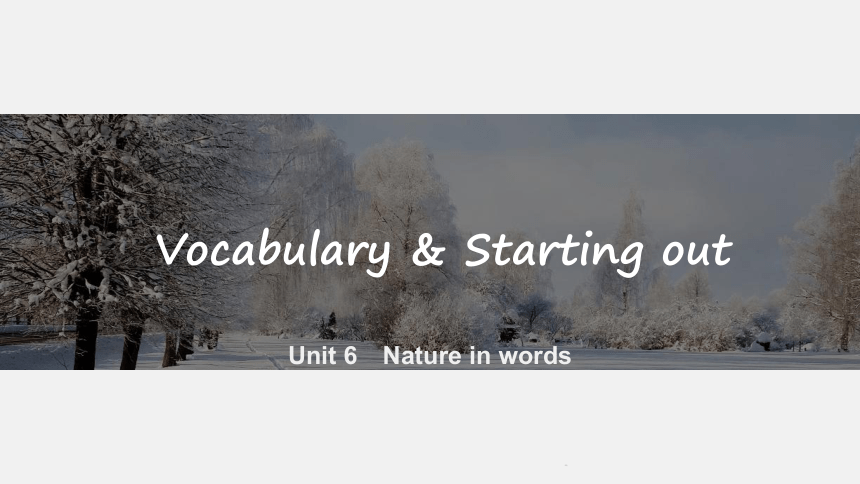 | |
| 格式 | pptx | ||
| 文件大小 | 31.0MB | ||
| 资源类型 | 教案 | ||
| 版本资源 | 外研版(2019) | ||
| 科目 | 英语 | ||
| 更新时间 | 2024-04-28 22:05:26 | ||
图片预览

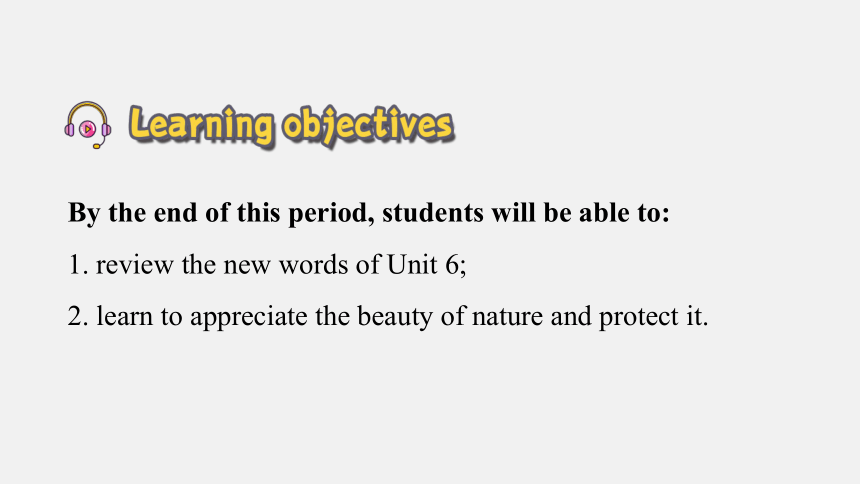
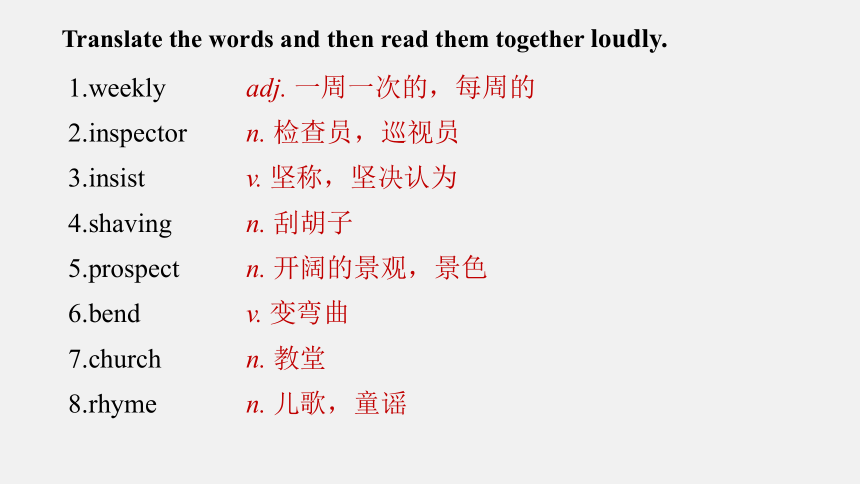
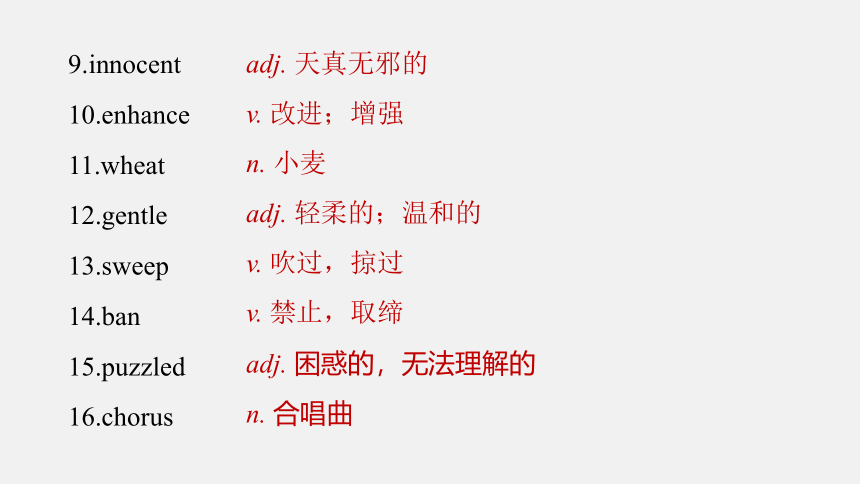
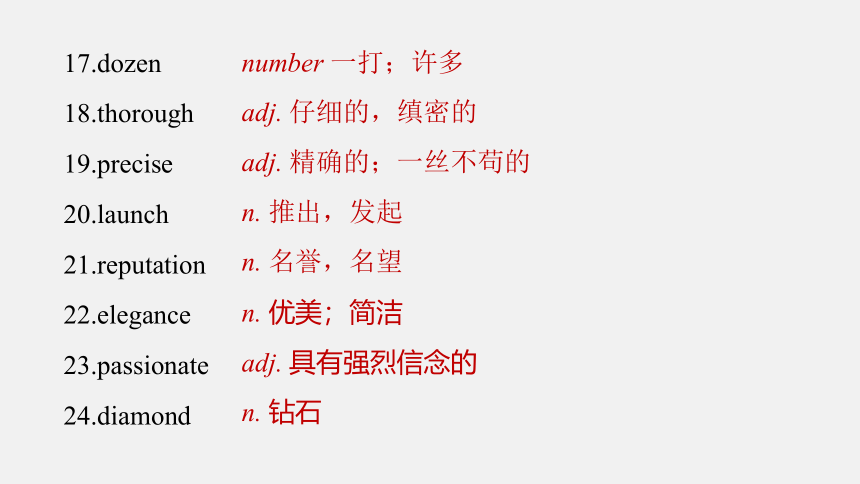
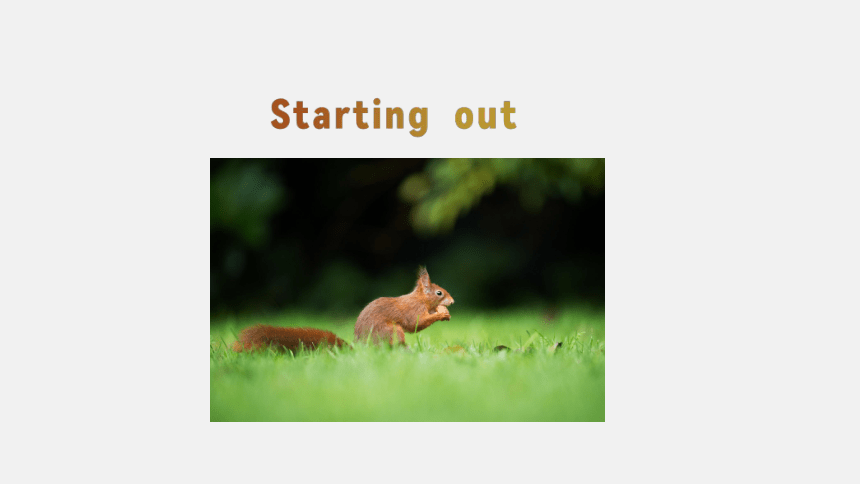
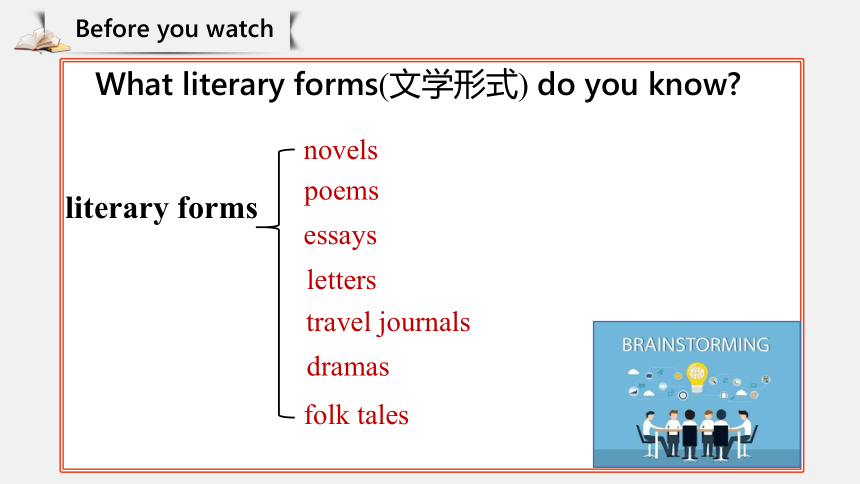
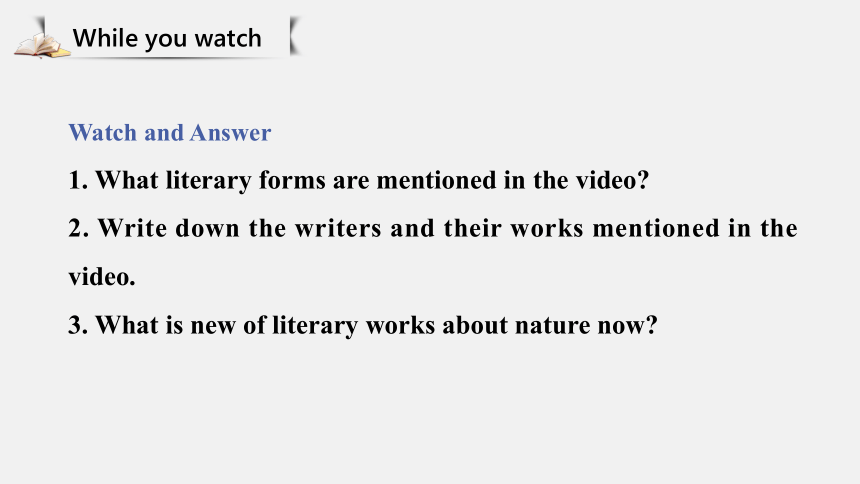
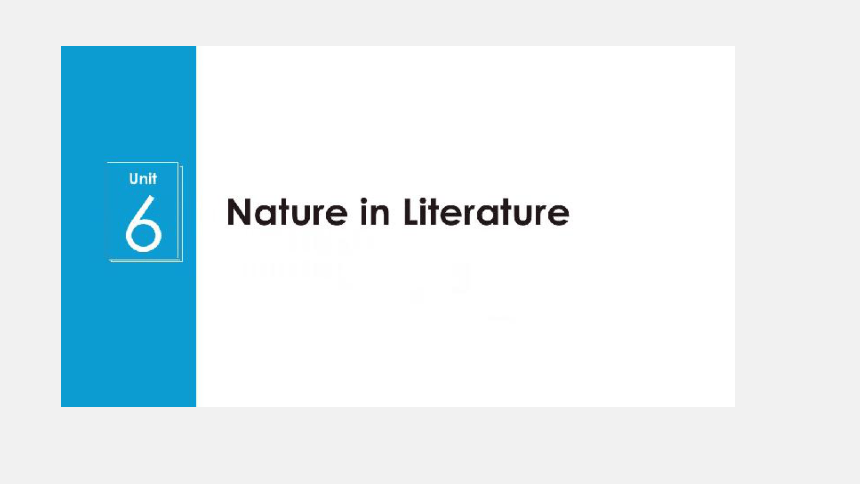
文档简介
(共21张PPT)
Vocabulary & Starting out
Unit 6 Nature in words
By the end of this period, students will be able to:
1. review the new words of Unit 6;
2. learn to appreciate the beauty of nature and protect it.
1.weekly
2.inspector
3.insist
4.shaving
5.prospect
6.bend
7.church
8.rhyme
adj. 一周一次的,每周的
n. 检查员,巡视员
v. 坚称,坚决认为
n. 刮胡子
n. 开阔的景观,景色
v. 变弯曲
n. 教堂
n. 儿歌,童谣
Translate the words and then read them together loudly.
9.innocent
10.enhance
11.wheat
12.gentle
13.sweep
14.ban
15.puzzled
16.chorus
adj. 天真无邪的
v. 改进;增强
n. 小麦
adj. 轻柔的;温和的
v. 吹过,掠过
v. 禁止,取缔
adj. 困惑的,无法理解的
n. 合唱曲
17.dozen
18.thorough
19.precise
20.launch
21.reputation
22.elegance
23.passionate
24.diamond
number 一打;许多
adj. 仔细的,缜密的
adj. 精确的;一丝不苟的
n. 推出,发起
n. 名誉,名望
n. 优美;简洁
adj. 具有强烈信念的
n. 钻石
What literary forms(文学形式) do you know
literary forms
poems
novels
essays
letters
travel journals
dramas
folk tales
Before you watch
While you watch
Watch and Answer
1. What literary forms are mentioned in the video
2. Write down the writers and their works mentioned in the video.
3. What is new of literary works about nature now
Poems, letters, travel journals, essays and novels are the literary forms mentioned in the video.
1. What literary forms are mentioned in the video
2. Write down the writers and their works mentioned in the video.
Ralph Waldo Emerson—Nature;
Thoreau—Walden;
Jack London—The Call of the Wild,White Fang.
3. What is new of literary works about nature now
Writers now are more aware of the vulnerability of nature, and they call for the protection of nature.
Nature in Literature
Nature has been a theme for writers throughout history. But not all writers have treated it in the same way. Some of the earliest works on nature are poems. In Chinese literature, Shanshui poetry dates from as early as the 4th century.
Surprisingly, “nature” does not really become a common theme for poets in Western cultures until the Romantic Movement in the late 18th century. For example, the earliest poems in Old English, which were composed in the 7th century AD, are about war, not nature. The earliest great nature poems which express a love for nature are probably those of the English Lake Poets in the early 19th century.
Much writing about nature emerges naturally from travel writing. In the 17th and 18th centuries wealthy young people from England often spent several years travelling around Europe—an experience which became known as the “Grand Tour”. Magnificent scenes from nature were described in detail in their letters home and in their travel journals.
After you watch
Task 1 Read the passage carefully.
Nature also makes an appearance in some famous essays, such as Ralph Waldo Emerson’s Nature. Thoreau’s memoir Walden is also famous for its depiction of nature.
Nature has also featured in novels, sometimes as an enemy of human beings. One of the greatest American novels,Moby Dick, is set on the high seas. Two popular early 20th-century novels by the writer Jack London—The Call of the Wild and White Fang—tell their stories from the point of view of a dog and a wolf, respectively. In these works, nature is cruel, and demands respect from humans.
Today, nature remains a prominent theme in literature. Its beauty and power continue to be described in vivid detail. What is new is that writers are more aware of its vulnerability, and are picking up their pens in a call for its protection.
Task 2 Read the poem by Emily Dickinson
艾米莉·狄金森是美国传奇诗人。狄金森的诗主要写生活、自然、生命、信仰、友谊、爱情。诗风凝练婉约、意向清新,描绘真切、精微,思想深沉、凝聚力强,极富独创性。她被视为二十世纪现代主义诗歌的先驱之一。
The poem of Emily Dickinson are considered to be some of the most original and defining works of American poetry. With a childhood love of reading and exploring nature, she grew up to be a keen observer of the people and places around her, and many of her poems convey a deep appreciation of the mystery and beauty of the natural world.
Emily Dickinson (1830-1886)
①
1. What images are used to symbolise nature
2. What message does the poem try to convey
Listen and read the poem by Emily Dickinson. Answer the questions.
“Nature “ Is What We See
by Emily Dickinson
“Nature” is what we see-
The Hill- the Afternoon-
Squirrel- Eclipse – The Bumble bee-
Nay- Nature is Heaven-
Nature is what we hear-
The Bobolink – The Sea-
Thunder- the Cricket-
Nay- Nature is Harmony-
Nature is what we know-
Yet have no art to say-
So impotent Our Wisdom is
To her Simplicity.
Nature is symbolised by simple images of
①a_______ and ②f_______, which are in turn symbolic of the poet’s thoughts and feelings about the simplicity of nature.
Nature is also symbolised in a metaphorical sense when it is described as “H______” and “H________”.
nimals
eatures
eaven
armony
The message of the poem is that although what we see and hear in nature appears to be simple, within that simplicity lie great beauty, mystery and magnificence that humans cannot truly appreciate or capture in their art.
“Nature” Is What We See
by Emily Dickinson
“Nature” is what we see —
The Hill — the Afternoon —
Squirrel — Eclipse — the Bumble bee —
Nay — Nature is Heaven —
Nature is what we hear —
The Bobolink — the Sea —
Thunder — the Cricket —
Nay — Nature is Harmony —
Nature is what we know —
Yet have no art to say —
So impotent Our Wisdom is
To her Simplicity.
eclipse:日食;月食
Bumble bee: 大黄蜂
cricket: 蟋蟀
bobolink: 食米鸟
Read the poem together!
Task 3 Discussion
What does nature mean to you
Homework
1. Read the words fluently and memorize them.
2. Preview the text in Understanding ideas.
THANKS
Vocabulary & Starting out
Unit 6 Nature in words
By the end of this period, students will be able to:
1. review the new words of Unit 6;
2. learn to appreciate the beauty of nature and protect it.
1.weekly
2.inspector
3.insist
4.shaving
5.prospect
6.bend
7.church
8.rhyme
adj. 一周一次的,每周的
n. 检查员,巡视员
v. 坚称,坚决认为
n. 刮胡子
n. 开阔的景观,景色
v. 变弯曲
n. 教堂
n. 儿歌,童谣
Translate the words and then read them together loudly.
9.innocent
10.enhance
11.wheat
12.gentle
13.sweep
14.ban
15.puzzled
16.chorus
adj. 天真无邪的
v. 改进;增强
n. 小麦
adj. 轻柔的;温和的
v. 吹过,掠过
v. 禁止,取缔
adj. 困惑的,无法理解的
n. 合唱曲
17.dozen
18.thorough
19.precise
20.launch
21.reputation
22.elegance
23.passionate
24.diamond
number 一打;许多
adj. 仔细的,缜密的
adj. 精确的;一丝不苟的
n. 推出,发起
n. 名誉,名望
n. 优美;简洁
adj. 具有强烈信念的
n. 钻石
What literary forms(文学形式) do you know
literary forms
poems
novels
essays
letters
travel journals
dramas
folk tales
Before you watch
While you watch
Watch and Answer
1. What literary forms are mentioned in the video
2. Write down the writers and their works mentioned in the video.
3. What is new of literary works about nature now
Poems, letters, travel journals, essays and novels are the literary forms mentioned in the video.
1. What literary forms are mentioned in the video
2. Write down the writers and their works mentioned in the video.
Ralph Waldo Emerson—Nature;
Thoreau—Walden;
Jack London—The Call of the Wild,White Fang.
3. What is new of literary works about nature now
Writers now are more aware of the vulnerability of nature, and they call for the protection of nature.
Nature in Literature
Nature has been a theme for writers throughout history. But not all writers have treated it in the same way. Some of the earliest works on nature are poems. In Chinese literature, Shanshui poetry dates from as early as the 4th century.
Surprisingly, “nature” does not really become a common theme for poets in Western cultures until the Romantic Movement in the late 18th century. For example, the earliest poems in Old English, which were composed in the 7th century AD, are about war, not nature. The earliest great nature poems which express a love for nature are probably those of the English Lake Poets in the early 19th century.
Much writing about nature emerges naturally from travel writing. In the 17th and 18th centuries wealthy young people from England often spent several years travelling around Europe—an experience which became known as the “Grand Tour”. Magnificent scenes from nature were described in detail in their letters home and in their travel journals.
After you watch
Task 1 Read the passage carefully.
Nature also makes an appearance in some famous essays, such as Ralph Waldo Emerson’s Nature. Thoreau’s memoir Walden is also famous for its depiction of nature.
Nature has also featured in novels, sometimes as an enemy of human beings. One of the greatest American novels,Moby Dick, is set on the high seas. Two popular early 20th-century novels by the writer Jack London—The Call of the Wild and White Fang—tell their stories from the point of view of a dog and a wolf, respectively. In these works, nature is cruel, and demands respect from humans.
Today, nature remains a prominent theme in literature. Its beauty and power continue to be described in vivid detail. What is new is that writers are more aware of its vulnerability, and are picking up their pens in a call for its protection.
Task 2 Read the poem by Emily Dickinson
艾米莉·狄金森是美国传奇诗人。狄金森的诗主要写生活、自然、生命、信仰、友谊、爱情。诗风凝练婉约、意向清新,描绘真切、精微,思想深沉、凝聚力强,极富独创性。她被视为二十世纪现代主义诗歌的先驱之一。
The poem of Emily Dickinson are considered to be some of the most original and defining works of American poetry. With a childhood love of reading and exploring nature, she grew up to be a keen observer of the people and places around her, and many of her poems convey a deep appreciation of the mystery and beauty of the natural world.
Emily Dickinson (1830-1886)
①
1. What images are used to symbolise nature
2. What message does the poem try to convey
Listen and read the poem by Emily Dickinson. Answer the questions.
“Nature “ Is What We See
by Emily Dickinson
“Nature” is what we see-
The Hill- the Afternoon-
Squirrel- Eclipse – The Bumble bee-
Nay- Nature is Heaven-
Nature is what we hear-
The Bobolink – The Sea-
Thunder- the Cricket-
Nay- Nature is Harmony-
Nature is what we know-
Yet have no art to say-
So impotent Our Wisdom is
To her Simplicity.
Nature is symbolised by simple images of
①a_______ and ②f_______, which are in turn symbolic of the poet’s thoughts and feelings about the simplicity of nature.
Nature is also symbolised in a metaphorical sense when it is described as “H______” and “H________”.
nimals
eatures
eaven
armony
The message of the poem is that although what we see and hear in nature appears to be simple, within that simplicity lie great beauty, mystery and magnificence that humans cannot truly appreciate or capture in their art.
“Nature” Is What We See
by Emily Dickinson
“Nature” is what we see —
The Hill — the Afternoon —
Squirrel — Eclipse — the Bumble bee —
Nay — Nature is Heaven —
Nature is what we hear —
The Bobolink — the Sea —
Thunder — the Cricket —
Nay — Nature is Harmony —
Nature is what we know —
Yet have no art to say —
So impotent Our Wisdom is
To her Simplicity.
eclipse:日食;月食
Bumble bee: 大黄蜂
cricket: 蟋蟀
bobolink: 食米鸟
Read the poem together!
Task 3 Discussion
What does nature mean to you
Homework
1. Read the words fluently and memorize them.
2. Preview the text in Understanding ideas.
THANKS
